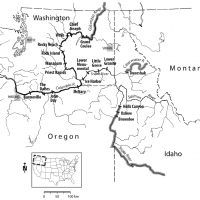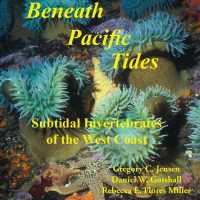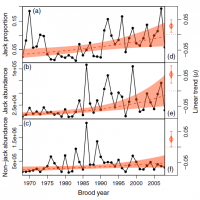Filter Results
Variability in body growth is an important part of variability in fish populations
It has long been established, indeed it is almost axiomatic, that annual variability in births of new fish (“recruitment”) is the most important reason why the total mass of fish populations varies from year to year. The rate of which individual fish grow (“body growth”) is also known to vary from year to year, but is generally considered to be fairly unimportant in explaining population variability.
Read moreA new guide on how to figure out which parts of DNA are actually expressed
Scientists trained in ecology and physiology are increasingly able to complement their work with the burgeoning field of “functional genomics”, i.e. the study of which parts of DNA (the “genome”) are actually expressed and used to make proteins under different conditions. A new guide is now provided for those from non-genetic fields to harness the power of fast computers and rapid technology in sequencing the letters in DNA, so that they can infer how animals respond to the environment.
Read moreThe blue-backed basslet, a new species from the Honduras
Reef fish species from waters deeper than 130 m are difficult to collect manually, because they are too deep for SCUBA divers. But now manned submersibles equipped with underwater vacuums are able to suck up new specimens with surprising alacrity. Among the specimens slurped up by one such submersible is brand new blue and gold species of basslet: the blue-backed basslet (Lipogramma adabeli), with distinct blue coloration, genetics, and habitat use distinguishing it from other similar species.
Read moreDesigning salmon-friendly dam turbines
The Columbia River used to host returns of nearly 9 million salmon every year, led by the largest returns in the world of Chinook salmon (4.4 million fish). But construction of multiple large dams on various tributaries and the Columbia River itself, eliminated salmon from vast tracts of rivers above impassable dams, and also had a serious effect on salmon survival in the remaining areas.
Read moreGreg Jensen Releases New Book: Beneath Pacific Tides
This winter, Greg Jensen is releasing his follow-up book, Beneath Pacific Tides: Subtidal Invertebrates of the West Coast. Like the charismatic crustaceans featured in his debut publication, the colorful and bizarre invertebrates found along the Pacific Coast are explored in this new user-friendly guide, featuring Jensen’s underwater photography.
Read moreAn explanation for suddenly elevated numbers of small “sneaker” males in Kodiak Island sockeye salmon
Male Pacific salmon usually compete aggressively with each other to gain access to spawning females, and are most successful when they are old and large. But a few males come back from the ocean early and small, and with less noticeable male traits. These small males are called “jacks” and cannot win battles of aggression but instead compete by sneaking into the spawning arena and fertilizing eggs on the sly.
Read moreCrosses between transgenic fish and wild fish can inherit rapid transgenic growth
Genetic engineering is widely used in plants and animals to promote rapid growth and create resistance to common diseases. One genetic modification that has achieved prominence in fish is the insertion of growth hormone transgenes, which produce dramatically larger sizes and rapid growth rates. However, there is concern that escaped genetically modified fish might breed with their wild counterparts, passing on the genetic modification and changing the wild population.
Read moreSpace travel requires more carbon than expected
Long-term life-support in space requires renewable sources of oxygen and food that can survive and thrive in a closed system without any external inputs. In a closed-system experiment, three species of green algae were added to a nutrient mixture together with a grazer species, the common water flea (Daphnia magna). Despite calculations of the appropriate level of carbon and nitrogen needed in the mixture, the pH in the closed system rapidly increased to become highly alkaline (pH 10-11), so much so that most forms of life would not be able to survive.
Read moreCommon pathways in fisheries management
Managing fisheries usually follows one of three pathways: limiting catches, limiting fishing effort, or limiting where fishing can take place. In a new review, each of these pathways is explored to examine their biological, social and economic implications. Limiting catches includes guideline harvests, strict limits on the total catch, allocations to groups, division of the total catch among individual participants, and fully transferable individual rights to catch a portion of the total allowable catch.
Read moreRise in water temperature will lead to earlier salmon hatch dates
Water temperatures affect the length of salmon incubation, including the periods between spawning and hatching, and between hatching and the emergence of free-swimming fry. In Bristol Bay, Alaska, lake temperatures are predicted to increase by 0.7-1.4°C from 2015 to 2099 at the time of the year when incubation occurs, due to the effect of human emissions of greenhouse gases. As a result, sockeye salmon in Alaska will start hatching 16 to 30 days earlier than at present, according to a new model that examined the effects of climate change on 25 populations of sockeye salmon in four Alaskan lakes.
Read more


